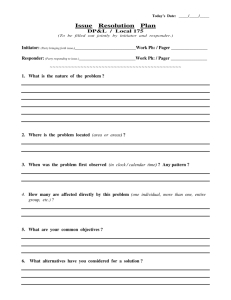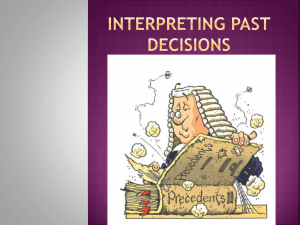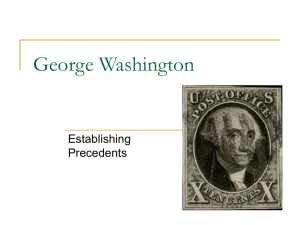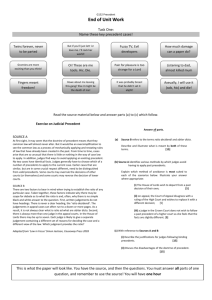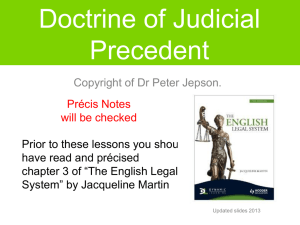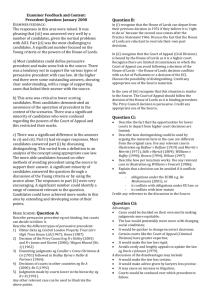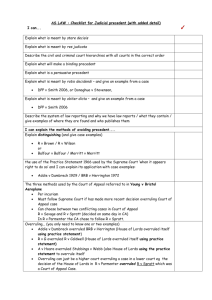LAW01 Judicial Precedent Revision v1
advertisement
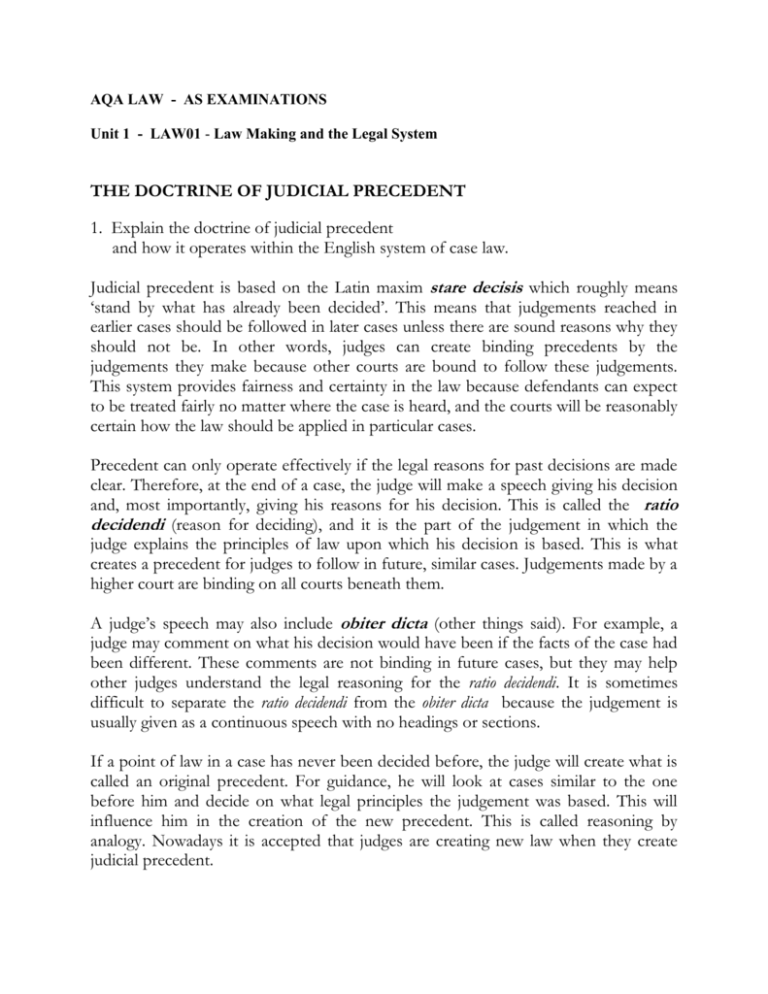
AQA LAW - AS EXAMINATIONS Unit 1 - LAW01 - Law Making and the Legal System THE DOCTRINE OF JUDICIAL PRECEDENT 1. Explain the doctrine of judicial precedent and how it operates within the English system of case law. Judicial precedent is based on the Latin maxim stare decisis which roughly means ‘stand by what has already been decided’. This means that judgements reached in earlier cases should be followed in later cases unless there are sound reasons why they should not be. In other words, judges can create binding precedents by the judgements they make because other courts are bound to follow these judgements. This system provides fairness and certainty in the law because defendants can expect to be treated fairly no matter where the case is heard, and the courts will be reasonably certain how the law should be applied in particular cases. Precedent can only operate effectively if the legal reasons for past decisions are made clear. Therefore, at the end of a case, the judge will make a speech giving his decision and, most importantly, giving his reasons for his decision. This is called the ratio decidendi (reason for deciding), and it is the part of the judgement in which the judge explains the principles of law upon which his decision is based. This is what creates a precedent for judges to follow in future, similar cases. Judgements made by a higher court are binding on all courts beneath them. A judge’s speech may also include obiter dicta (other things said). For example, a judge may comment on what his decision would have been if the facts of the case had been different. These comments are not binding in future cases, but they may help other judges understand the legal reasoning for the ratio decidendi. It is sometimes difficult to separate the ratio decidendi from the obiter dicta because the judgement is usually given as a continuous speech with no headings or sections. If a point of law in a case has never been decided before, the judge will create what is called an original precedent. For guidance, he will look at cases similar to the one before him and decide on what legal principles the judgement was based. This will influence him in the creation of the new precedent. This is called reasoning by analogy. Nowadays it is accepted that judges are creating new law when they create judicial precedent. 2. Explain how precedent works within the hierarchy of courts. In England and Wales the courts operate a rigid doctrine of judicial precedent. This means that every court is bound to follow any judgement made by a court above it in the judicial hierarchy. Since 1973, the highest court affecting the English legal system is the European Court of Justice. Decisions made by the ECJ are binding on courts throughout the European Union. The most senior national court is the House of Lords. Its decisions bind all other courts in the English legal system. From 1898 (London Street Tramways v London County Council until 1966, the House of Lords was bound by its previous precedents. However, the Practice Statement 1966 allows the Lords to depart from previous precedents where it is in the interests of fairness and justice so to do. The Practice Statement 1966 allows the Lords more flexibility, but they use this power sparingly as they wish the public to have confidence that the law is as certain as it can be. Below the House of Lords is the Court of Appeal which has two divisions: Civil and Criminal. With limited exceptions, the Appelate Courts are bound by their own past precedents. The Criminal Division is allowed more flexibility than the Civil Divisions where the point at issue involves the liberty of the defendant. Below the Court of Appeal are the three Divisional Courts (Queen’s Bench, Chancery and Family). These courts are bound by the decisions of the courts above them. They are also in general bound by their own past decisions. The High Court is bound by the decisions of all the courts above it, and in turns it binds the courts beneath it. High Court judges follow each other’s decisions though they are not obliged to do so. The so-called inferior courts are the Crown Court, the County Court, and the Magistrates’ Court. They are bound to follow the decisions of the superior courts, and it is unlikely that a decision created by an inferior court can create precedent. 3. Explain the role of law reporting in the system of precedent. For precedent to be effective there must be an accurate record of what decisions have been made by the courts. In 1865 the Incorporated Council of Law was established and controlled by the courts to report the law. Judgements are noted down exactly as delivered by the judge to ensure accuracy. Other well-established reports include the All England series (All ER) and the Weekly Law Reports (WLR). In addition, all High Court, Court of Appeal and the Law Lords cases are reported on the Internet. Quality newspapers and journals also publish law reports; these are summarised versions in which the law reporter tries to identify and explain the essential parts of the judgement. Explain: case law stare decisis binding precedent hierarchy of courts Appeal courts Practice Statement 1966 ratio decidendi obiter dicta Law Reporting – Incorporated Council of Law Reporting 1865 – All England law reports – Weekly Law Reports – Internet reporting – newspapers and journals www.lawreports.co.uk (summaries of important cases in the Daily Law Notes section) www.publications.parliament.uk (reports of cases from the House of Lords) www.bailii.org (cases from the Court of Appeal) 4. Discuss whether the doctrine of precedent allows judges flexibility in developing the law (distinguishing, overruling, reversing) As society changes and develops, our laws must be able to reflect these changes if they are to be seen as fair and relevant. Judges have a number of ways to avoid precedent, so they have room to manoeuvre in giving judgement. Distinguishing is the main device used by judges in all courts for avoiding a binding precedent. No two cases are exactly the same. Therefore, a judge may regard the facts of the case before him to be sufficiently different from the facts of the case in which the binding precedent was set. In these circumstances, the judge is not bound to follow the original precedent; they may distinguish the case on its material facts. This creates a second binding precedent. The original precedent remains binding in cases of the same material facts. These two cases show how the distinguishing process operates. Balfour v Balfour (1919) and Merritt v Merritt (1971) both involved a wife making a claim against her husband for breach of contract. However, in Balfour there was merely a domestic agreement between husband and wife, while in Merritt husband and wife had made an agreement in writing after they separated. The court distinguished the facts between the cases and created a new precedent based on Merritt. Balfour, of course, remained the precedent for cases similar to itself. Overruling occurs where a court in a later case states that the legal rule decided in an earlier case is wrong. For example, the House of Lords can overrule a decision of the Court of Appeal by declaring the Court of Appeal reached the wrong legal rule. The House of Lords may also use its power under the Practice Statement 1966 to overrule one of its own past decisions. For example, in Davis v Johnson (1979) the Lords ruled that judges could not use Hansard (the record of what is said in Parliament) to try and decide what certain words in an Act of Parliament meant. However, in Pepper v Hart (1993) the Lords overruled David v Johnson (1979) and created a new precedent allowing judges to consult Hansard. Reversing occurs where a higher court reverses the decision of a lower court on appeal in the same case. In other words, reversing is where the same case has gone to appeal and the higher court reaches the opposite decision to that of the lower court. For example, in Fitzpatrick v Sterling Housing Association Ltd (2000), the Court of Appeal refused to allow a homosexual partner of the deceased tenant to take over the tenancy as he could not be considered part of his family as required under the Rent Act 1977. Fitzpatrick appealed to the House of Lords who reversed the decision of the Court of Appeal, so giving same-sex partners the same right as different sex partners. (It is important you make the difference between overruling and reversing clear. Many candidates muddle the explanations). Distinguishing: avoiding a previous precedent because the facts in the present case are materially different. Balfour v Balfour (1919) not followed in Merritt v Merritt (1971). Overruling: avoiding a precedent by stating the legal ruling in an earlier case is wrong. Pepper v Hart (1993) overruled and replaced Davis v Johnson (1979) on the use of Hansard. Reversing: a higher court overturns the decision of a lower court on appeal. This can only happen if the case is appealed to a higher court. In Fitzpatrick v Sterling Housing Association Ltd (2000), the House of Lords overturned the decision of the Court of Appeal. 5. Outline and briefly explain the court structure. European Court of Justice It is necessary for there to be a settled court hierarchy as judges need to know what judicial precedents they are bound to follow. Since 1973, the European Court of Justice has been the highest court affecting our legal system. A decision made by the ECJ is binding on all courts in the European Union, including those of the United Kingdom. The ECJ is prepared to overrule its own past decisions if it feels this is necessary. European courts are generally more flexible than courts in the United Kingdom. The House of Lords is the senior national court and its decisions bind all other courts in the English legal system. Until 1966, the HL regarded itself as bound by its own previous decisions, unless the decision was made per incuriam (‘through lack of care’). However, Practice Statement 1966 stated that the HL in future would be free to depart from its own previous decision “where it appears right to do so”. However, this freedom is used sparingly so as to maintain certainty and consistency in decisions. Pepper v Hart (1993) overruled David v Johnson (1979). The Court of Appeal (CA) is directly below the House of Lords in the court structure. It is divided into two divisions, the Civil Division and the Criminal Division. As a general rule, the Court of Appeal is bound by its own previous decisions with some limited exceptions to this rule. The Criminal Division is permitted to be more flexible where the decision involves the liberty of the defendant. The High Court contains three separate appeal courts: The Queen’s Bench, Chancery, and Family. All three are bound by decision of the Court of Appeal. The House of Lords and the European Court of Justice. The Divisional Courts, with a few exceptions, are bound by their own decisions. The Crown Court, the County Court and the Magistrates’ Court are described as inferior courts. This is because they are bound to follow decisions made by all higher courts. In addition, it is unlikely that a decision made by an inferior court can create binding precedent. In theory, the Crown Court can set precedent for the Magistrates’ Court on a point of law; however, since such decisions are hardly ever recorded they have little practical effect. 6. Discuss the advantages and disadvantages of the system of precedent. Advantages The system of judicial precedent has several advantages, including certainty, consistency and fairness, precision and flexibility. Precedent provides certainty because the courts must follow decisions made in previous similar cases. Precedents are established by the ratio decidendi and explained in the obiter dicta. This means people know what the law is and how it is likely to be applied in their case. For example, a lawyer can advise his client about the likely outcome of his case, based on the knowledge of precedent in similar cases. It also allows people in business to make financial and other arrangements secure they will be recognised and supported by the law. The Practice Statement 1966 reminds us how important certainty is in the law. Precedent provides consistency and fairness because defendants know they will receive the same treatment no matter where their case is heard or who is hearing the case. As in sport, the rules of law will be applied equally to both sides. Precedent also means that judges cannot make random or arbitrary decisions because judges are bound to apply binding precedent in similar cases. However, judges also have considerable flexibility in avoiding precedent by distinguishing, overruling and reversing. For example, the House of Lords can now use the Practice Statement 1966 to change the law when necessary; for example, Pepper v Hart (1993) overruled and replaced Davis v Johnson (1979) on the use of Hansard. Precedent provides precision in law-making. As new precedents are established, English case law becomes more and more precise. For example, the judge was able to distinguish between Balfour v Balfour (1919) and Merritt v Merritt (1971), so that we new have precedents appropriate to cases similar in the material facts to these cases. Disadvantages The system of judicial precedent has several disadvantages, including rigidity, complexity and slowness of growth. Although judges can avoid precedent by distinguishing, reversing, and overruling, there is still a degree of rigidity or inflexibility in the system. For example, although Crown Courts hear very serious cases, they cannot create binding precedent. This means too many cases go to the Court of Appeal that could be dealt with in the lower courts. In addition, the Court of Appeal itself is generally bound by its own decisions, so many cases that could be dealt with on appeal are passed up to the House of Lords. However, the Law Lords can only hear about 50 cases a year. This makes the system slow and cumbersome , and means that bad precedents may be in force far longer than necessary. Sometimes there is a very long wait for a suitable case to be appealed ball the way to the House of Lords. The system of precedent has become increasingly complex. Distinguishing is useful in avoiding past decisions, but it has made the law very complex in some areas because the differences in the material facts may be so small to justify yet another precedent. There are nearly half a million reported cases, so it is not easy to find all the relevant law even with computerised data bases. Another problem is in the judgements themselves, which are often very long with no clear distinction between the reason for the decision (ratio decidendi) and other things said by the judge (obiter dicta). This makes is difficult in some cases to extract the ratio decidendi. Indeed, in Dodd’s Case (1973), the judges in the Court of Appeal said they were unable to find the ratio decidendi in a decision of the House of Lords. THE DOCTRINE OF JUDICIAL PRECEDENT - TEST YOURSELF How Precedent operates within the English system of Case Law 1. 2. 3. 4. 5. 6. 7. 8. 9. 10 12 13 14 On what Latin maxim is judicial precedent based? What does this maxim mean? What do you understand by ‘binding’ precedent? What does the system of precedent provide, and how? Why must the legal reasons for past decisions be made clear? In one word, what do we call the judge’s speech at the end of case? What does the ratio decidendi explain? What does the ratio decidendi create? What is the meaning of obiter dicta? What might the obiter dicta contain? What difficulty sometimes arises between the ratio decidendi and the obiter dicta? Explain the meaning of ‘original precedent’. Where will the judge look for guidance in creating an original precedent? What kind of reasoning is this? 15 In relation to precedent, what is generally accepted nowadays? How precedent works within the hierarchy of courts 1. 2. 3. 4. 5. Why can the doctrine of precedent be described as rigid? Since 1973, what has been the highest court affecting English law? Why are decisions made by the ECJ so powerful? What is the most senior national court in the United Kingdom? Explain the significance of London Street Tramways v London County Council (1898). 6. Why do you think the Lords reached this decision in 1898? 7. What does the Practice Statement 1966 empower the Lords to do? 8. When is this power used? 9. Why is this power used sparingly? 10 Name the two Divisions of the Court of Appeal. 11 Which Division is allowed more flexibility, and why? 12 Name the three Divisional Courts below the Court of Appeal. 13 These three Divisional Courts are bound by the decisions of the courts above them, but are they also bound by their own past decisions? 14 To what extent is the High Court bound by precedent? 15 Explain how precedent affects the so-called inferior courts. The role of law reporting in the system of precedent. 1. 2. 3. 4. 5. Why is it essential that ratio decidendi are reported accurately? Explain the importance of the Incorporated Council of Law 1865. Name two organisations who regularly report new precedents. Where are cases heard in High Court, Court of Appeal and the Law Lords now reported? Where can the general public read abbreviated reports of important cases? Flexibility in developing the law (distinguishing, overruling, reversing) Avoiding Precedent distinguishing overruling reversing 1. 2. 3. 4. 5. 6. Why must judges be able to avoid precedent? What is the main device used by judges in all courts for avoiding a binding precedent? On what grounds does a judge distinguish between two cases? What do you understand by ‘the material facts’ of a case? When a judge distinguishes between two cases because of their material facts, how many precedents become operative? Explain in some detail how Balfour v Balfour (1919) and Merritt v Merritt (1971) are very useful in demonstrating how two cases may be distinguished from each other. 7. 8. In avoiding precedent, explain how overruling occurs. Give an example of how the House of Lords can overrule a decision of the Court of Appeal. 9. How have the House of Lords been empowered to overrule their own past decisions? 10 Explain in some detail how the Lords used Pepper v Hart (1993) to overrule their earlier decision in Davis v Johnson (1979). 11 In avoiding precedent, explain how reversing occurs. 12 In other words,………… Complete the sentence. 13 Explain in some detail how Fitzpatrick v Sterling Housing Association Ltd (2000) is very useful in demonstrating how reversing occurs. THE ADVANTAGES & DISADVANTAGES OF JUDICIAL PRECEDENT Advantages of Judicial Precedent Complete the sentences The system of judicial precedent has several advantages, including c……..y, f..rness, pre…ion and fl...ibility con……cy and Firstly, precedent provides certainty because the courts must ………………………. similar cases. Precedents are established by the ratio ……………… and explained in the ……………… . This means people know what the law is and how it is likely to be ……. in their case. For example, a lawyer can advise his client about the likely ……. of his case, based on the ……… of precedent in similar cases. It also allows people in business to make financial and other …………… secure they will be recognised and supported by the law. The Practice Statement 1966 reminds us how important ………….. is in the law. Secondly, precedent provides consistency and fairness because defendants know they will receive the ….. treatment no matter where their case is heard or who is ……. the case. As in sport, the rules of law will be applied ……. to both sides. Precedent also means that judges cannot make r….m or ar…rary decisions because judges are bound to apply b……g precedent in similar cases. However, judges also have considerable flexibility in avoiding precedent by dis……….ing, over…..g and rev….ing. For example, the House of Lords can now use the Practice Statement 1966 to change the law when necessary; for example, Pepper v Hart (1993) overruled and replaced Davis v Johnson (1979) on the use of Ha….d. Thirdly, precedent provides precision in law-making. As new precedents are ……….., English case law becomes more and more precise. For example, the judge was able to d……….h between Balfour v Balfour (1919) and Merritt v Merritt (1971), so that we new have precedents ap………..te to cases similar in the mat….l facts to these cases. Disadvantages of Judicial Precedent Complete the sentences The system of judicial precedent has several disadvantages, including rigidity, complexity and slowness of growth. Firstly, although judges can avoid precedent by d…………..g, re…..ing, and over…ing, there is still a degree of rigidity or inflexibility in the system. For example, although C…n Courts hear very serious cases, they cannot create b…..g precedent. This means too many cases go to the Court of Ap….l that could be dealt with in the l…r courts. Secondly, the Court of Appeal itself is generally b…d by its own decisions, so many cases that could be dealt with on appeal are p….d up to the House of Lords. However, the Law Lords can only hear about ….. cases a year. This makes the system slow and cumbersome , and means that bad precedents may be in f…e far longer than necessary. Sometimes there is a very long wait for a s…..le case to be appealed all the way to the House of Lords. Thirdly, the system of precedent has become increasingly complex. Distinguishing is useful in avoiding p..t decisions, but it has made the law very co..lex in some areas because the differences in the ma…ial facts may be so small to ju…fy yet another precedent. There are nearly half a mi..ion reported cases, so it is not easy to find all the relevant law even with computerised data bases. Fourthly, another problem is in the judgements themselves, which are often very long with no cl..r distinction between the reason for the decision (ratio decidendi) and other things said by the judge (obiter dicta). This makes is di..icult in some cases to extract the ratio decidendi. Indeed, in Dodd’s Case (1973), the judges in the C…t of App..l said they were unable to find the ratio decidendi in a de…ion of the House of Lords.
